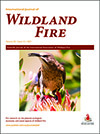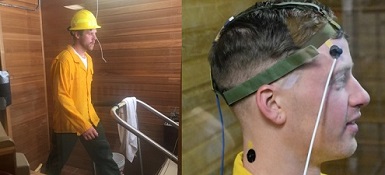International Journal of Wildland Fire
Volume 30
Number 12 2021
Integrated datasets are needed to evaluate fire models. At present, publicly available, co-located, temporally synchronised, quality-assured, multiscale measures of pre-fire, active-fire and post-fire conditions are rare, thus hindering model evaluation efforts. We present established methods to aid in the delivery of integrated data to evaluate fire models.
Surface fuels, which strongly influence fire behaviour, are spread unevenly across the landscape. Quantifying how fuel loads vary across space will improve fire behaviour modelling and could help in making better land management decisions. Site preparation that commonly accompanies tree planting has ancillary benefits of reducing wildland fuel load and continuity.
This paper reports on the outcomes of an operational trial to create a fine-scale fire mosaic in south-west Australian forest landscapes. Mosaic grain size and seral diversity were a function of landscape fire frequency and weather conditions at the time of the fire.
Fire and land agencies are increasingly investing in predictive services for planning and operational response to wildfires. Previous studies suggest that institutional investment is a poor indicator of services being used. We surveyed predictive services users in Australia and found further evidence that social dynamics, such as interpersonal trust, shape utilisation.
Lightning is the main cause of natural wildland fires worldwide. Although wildfires in Mediterranean countries are mostly human-caused, the small fraction ignited by lightning can also develop into devastating wildfires. The present work studies the characteristics of the thunderstorms that produce lightning-caused wildfires in Catalonia, north-eastern Iberian Peninsula.
There is large variation – over small distances – in post-fire juvenile period and maturation rates (age at three times flowering) of Proteas in the Cape fynbos of South Africa. The more conservative fire return interval guidelines (50% rule) for prescribed burns should be followed.
Plants can minimise damaging effects of high temperatures through protective mechanisms; however, it is unknown how these mechanisms respond to extreme temperatures associated with wildfire. Previous fire exposure led to changes in the content of stress proteins and to a fairly long-term ‘heat stress memory’ in Scots pine needles.
This investigation addressed the effects of wearing a standard wildland firefighter helmet on heat accumulation. It was found that compared with not wearing a helmet, subjects exercising in a heat chamber wearing wildland firefighter personal protective equipment accumulated heat and experienced redirection of blood flow to the head. Photographs (by T. Stenersen) show helmet trial in heat chamber (left) and non-helmet trial subject preparation (right).






